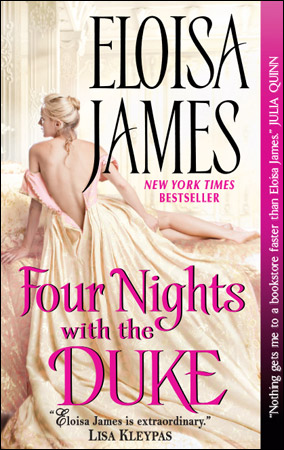
Exclusive Extras
Inside Four Nights with the Duke
Warning! In describing relations between characters, I may wreck a book for you by making it clear who someone marries, or the outcome of a book. Please do not read about The Inside Take if you're wary of knowing who is paired with whom!
- Four Nights with the Duke follows Three Weeks with Lady X, the tale of Thorn and India, who also appear in this novel. From the moment Vander told Thorn, in Three Weeks, that he wanted the type of marriage that the Duke of Villiers had, I knew that he would be the best kind of hero—the alpha who is intently anti-romantic, but can’t stop himself from falling deeply in love.
- The Duke of Villiers also appears in Four Nights, and he too is from an earlier novel or, in his case, a whole series of novels. Villiers appears in every book in the Desperate Duchesses series. In the arc of that series, he plays something of a Cupid figure, somehow entangled in the primary romance. In the very last book, A Duke of Her Own, he himself falls in love and ends up with the kind of marriage that Vander wants.
- I talked a bit about 19th century women novelists in the historical note at the end of Four Nights, but I wanted to add a note here about novel-writing in the present. Mia’s journey in the book—from creating perfect heroines to shaping a heroine who is much more like herself, albeit involved in a fanciful plot—is taken from my own career. It took me several books to learn that heroines can be imperfect, physically and otherwise.
- Read the deleted scene which would have appeared after the Prologue, and a second deleted scene with an appearance from India and Thorn, the main characters from Three Weeks with Lady X.
- Another aspect of the world of contemporary romance shows up in sly references to two of my best friends: Miss Julia Quiplet is Julia Quinn and Mrs. Lisa Klampas is Lisa Kleypas.
- In the historical note, I pointed out Chuffy’s indebtedness to Sir Toby Belch in Twelfth Night, and Charlie’s to Charles Wallace in A Wrinkle in Time. I owe another literary debt to Percy Bysshe Shelley’s “Love’s Philosophy,” in which moonbeams kiss the sea. If you’d like to read the entire poem, it can be found here.






